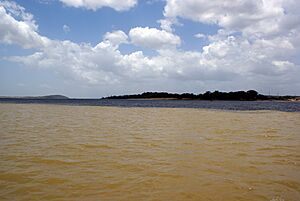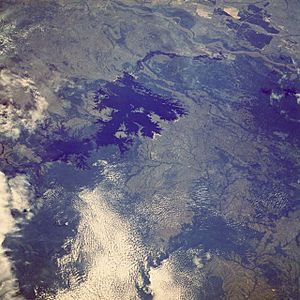Caroní River facts for kids
Quick facts for kids Caroní River |
|
|---|---|
 |
|
| Country | Venezuela |
| Physical characteristics | |
| Main source | Confluence of the Kukenan- and the Yuruani Rivers 2,650 m (8,690 ft) |
| River mouth | Orinoco River in Ciudad Guayana |
| Length | 952 km (592 mi) |
| Basin features | |
| Basin size | 95,000 km2 (37,000 sq mi) |
The Caroní River is a very important river in Venezuela. It is the second longest river in the country. It also has the second highest amount of water flowing through it. The Caroní River stretches for about 952 kilometres (592 mi). It starts near the Kukenan tepui, which is a flat-topped mountain. The river then flows until it meets the Orinoco River. This meeting point is in Bolivar State.
Contents
How the Caroní River Flows
The Caroní River carries a huge amount of water. It is one of the rivers with the highest water flow in the world. On average, about 4,850 cubic metres per second (171,000 cu ft/s) of water flows through it. This amount changes with the wet and dry seasons. During the wet season, more water flows. During the dry season, less water flows.
One special thing about the Caroní River is its dark color. It looks almost like black tea! This color comes from natural acids. These acids are created when plants in the forest break down slowly. Because of its dark water, the Caroní is called a blackwater river. The Negro River in Brazil is another famous blackwater river.
The Caroní River Basin
The Caroní River flows through a large area called its basin. This basin covers about 95,000 square kilometres (37,000 sq mi). It is part of the even bigger Orinoco River basin. The Caroní basin is home to the Guayanan Highlands moist forests.
The Caroní River and its smaller rivers, like the Paragua, have a unique shape. They are like a "staircase." This means they have many waterfalls and fast-flowing parts called rapids. These are mixed with calmer sections where the river flows gently. In these calm parts, the river often makes big loops called meanders. Sometimes, these loops get cut off, forming oxbow lakes.
Some of the world's most amazing waterfalls are found in this basin. Angel Falls is the highest free-falling waterfall in the world. Its water drops almost 1,000 metres (3,300 ft)! Kukenan Falls is also very tall, dropping about 610 metres (2,000 ft). Other beautiful waterfalls include Aponwao, Caruay, and La Llovizna.
Generating Power from the River
The Caroní River is perfect for making hydroelectric energy. This is electricity made from the power of moving water. The river has a lot of water and drops steeply in many places. This makes it ideal for building power plants.
There are four main hydroelectric plants along the Caroní River:
- Macagua I, II, and III: These are located close to where the Caroní meets the Orinoco.
- Caruachi: This plant is about 30 kilometres (19 mi) upstream from Macagua.
- Guri: This is the biggest plant on the Caroní. It is about 80 kilometres (50 mi) from Puerto Ordaz. The Guri plant has a huge lake behind its dam, called the Guri Reservoir. This lake covers about 4,000 square kilometres (1,500 sq mi). The Guri plant is one of the largest hydroelectric power plants in the world. It can produce 10,000 megawatts of power.
National Parks Along the River
The upper parts of the Caroní River and its smaller rivers (like Aponguao, Cuquenán, and Yuruaní) flow through a beautiful area called the Gran Sabana. Part of this area is protected as Canaima National Park. This park is famous for its unique landscapes and tepuis.
Mining and the Environment
There are some small-scale gold mines along the Caroní River. These mines are mostly outside the national park. However, some are found inside Canaima National Park. Mining can cause harm to the environment. When land is cleared for mines, it leads to deforestation. A bigger problem is the use of mercury in gold mining. Mercury is a dangerous chemical that can poison the river. It harms the animals living in the water and people who live along the river. High levels of mercury have been found in the Caroní River and in Lake Guri. Efforts are being made to reduce these harmful mining activities.
See also
 In Spanish: Río Caroní para niños
In Spanish: Río Caroní para niños




